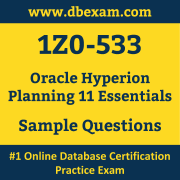01. Based on the following design:
Plan type 1: Summary Plan type with all Accounts by Entity
Plan type 2: Sales Plan type with Gales by Product by Entity
Plan type 3: Salary Plan type with Salary Expense by Employee by Entity
You need to get Sales data to the Summary plan type. Identify the two true statements about sharing revenue data between the sales plan type and the summary plan type.
a) Planning will build in @XREF calculations in a calc script by default to share data between plan types.
b) A replicated partition could be created to replicate data from the sales plan type to the summary plan type and this would be done if we wanted to store the sales data in the summary plan type.
c) A transparent partition and @XREF calculations could have performance issues for retrievals because data is not stored; it is dynamically calculated.
d) A calc export script on the source database with the DATA EXPORT command could be used I export data out of the revenue plan type and calc import script on the target database with the DATA IMPORT command could be used to import the data file to the summary plan type.
e) To disable the building of @XREF, update theHSPProperties file for the application before you click Create during the application creation process.
02. You have a new Planning administrator to manage the Capital Expenditure application. He will assign security for the application as well as maintain dimensions.
In FPMA, Business Rules in Calculation Manager, and load data via Essbase rules files. He will not need access to other applications.
Choose the two valid roles that will address part or this entire requirement.
a) Administrator for the CapEx application
b) Administrator for the Planning Server
c) Provisioning Manager for the CapEx application
d) Planning Calculation Manager for the CapEx application
e) Dimension Editor for the CapEx dimensions
f) Application Manager in Essbase for the CapEx dimensions
03. Identify the three true statements about attribute dimensions.
a) Planning supports hierarchies and aliases for attribute dimensions.
b) Planning supports all attribute types (for example. Boolean, Date, Text).
c) Planning supports varying attributes (where an attribute can vary over one or more other dimensions).
d) Attribute dimensions can be assigned to dense dimensions.
e) Attribute dimensions may only be assigned to one base dimension.
04. A Business Rule is launched from a data form. What will Planning utilize to provide a valid list of members for a run-time prompt?
a) Members defined on the data form
b) Planning Metadata security
c) Business Rules security access privileges
d) Essbase security filters
e) Business Rules Basic User Role
05. In the Workforce Planning module, an employee is terminated. What two activities do you perform in WFP, so that total salary numbers are correctly calculated?
a) Run a business rule to change the employee's status.
b) Change the employee's status on a data form using the Smart List drop down.
c) Change the employee's status on a data form using the free form text measure.
d) Change the employee status attribute association in the Employee dimension.
e) Delete the employee from Workforce Planning.
06. A planning unit is the basic unit ______.
a) for preparing, reviewing, and approving data.
b) for calculating and storing currency plan data.
c) for assigning security to plan data.
d) for reporting and analyzing plan data.
e) made up of Scenario, Entity, and Account.
07. The Hyperion Planning administrator needs to run several calculations in a specific order against two different databases within the application.
Identify the two options that are not valid.
a) Esscmd
b) Calc Script
c) Business Rule Sequence
d) MaxL
e) Business Rule Macro
08. When opening a data form, the user experiences slow performance. What three steps could you do to improve the time it takes to open the data form?
a) Reduce the number of rows and columns displayed in the data form.
b) Upgrade the client machine's operating system processing speed and RAM.
c) In the data form definition, remove the option to display alias.
d) Reduce the number of page dimensions used on the Web form
e) Tune the index and data caches in Essbase.
09. You've created an EAS business rule and assigned it to the data form but an end user can't see it. What are two valid reasons?
a) The user doesn't have the Launch Business Rules role in Shared Services.
b) The user hasn't been assigned Validate and Launch Privileges in EAS.
c) The location for the Business Rule hasn't been defined.
d) The user hasn't been assigned access to the Business Rule in the Planning Web client.
10. What are the correct predefined types of base time periods that can be established when creating the calendar in a planning application?
a) Weekly, Monthly, Quarterly, Custom.
b) Monthly, Quarterly, Custom.
c) Monthly, Quarterly, Weekly.
d) Weekly, Monthly, Quarterly, Yearly, Custom.
e) Only Custom periods are possible.
 The Oracle Hyperion Planning Essentials (1Z0-533) Sample Question Set is designed to help you prepare for the Oracle Hyperion Planning 11 Certified Implementation Specialist certification exam. To become familiar with the actual Oracle Certification exam environment, we suggest you try our Sample Oracle 1Z0-533 Certification Practice Exam.
The Oracle Hyperion Planning Essentials (1Z0-533) Sample Question Set is designed to help you prepare for the Oracle Hyperion Planning 11 Certified Implementation Specialist certification exam. To become familiar with the actual Oracle Certification exam environment, we suggest you try our Sample Oracle 1Z0-533 Certification Practice Exam.